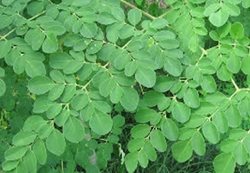In the last few weeks, I have been thinking about what cultural stigmas could cause us to reject the potential of a better future?
In the early part of July I was in David Sharland's garden, in Arua in the very northwest edge of Uganda. David is married to Heather who was brought up in Draperstown. Some of you might remember her as Heather Sinclair who made news headlines in 1987 when she was kidnapped by Sudanese rebels and held for some weeks. You might even have prayed for her. Anyway, that is another story.
The Moringa Tree
David works in agriculture and his garden is amazing. I watched him as he captured the attention of our teenagers, entertaining them with stories about all kinds of herbs and plants and trees.
 When he came to the Moringa tree he shocked me. He waxed lyrical, with his usual enthusiasm, about its many wonders and then he told us that the Moringa leaf could relieve the nutritious needs of millions of malnourished people in Africa.
When he came to the Moringa tree he shocked me. He waxed lyrical, with his usual enthusiasm, about its many wonders and then he told us that the Moringa leaf could relieve the nutritious needs of millions of malnourished people in Africa.
Moringa leaves have 9 times the protein of yogurt, 10 times the vitamin A of carrots, 15 times the potassium of bananas, 17 times the calcium of milk, 12 times the vitamin C of oranges and 25 times the iron of spinach! In most places it easily available, just growing at the side of the road.
BUT… in African culture to eat leaves is what you do if you are so poor that you are dying of starvation. So, you couldn’t be caught eating leaves. It’s a cultural no no! As David spoke I was staggered at how some cultural taboo could get in the way of saving lives.
It would have been easy to have left David’s garden thinking about how stupid those impoverished Africans are. My mind, however, was already back home in our wee corner of the world.
There is a stain glass window at Belfast City Hall. The plaque beside it speaks of the window representing the successes of the city over 100 years. There is a tree at the top of the window. The plaque reads, “The tree with the sun behind it symbolises hope, growth, regeneration and reconciliation.” It then quotes Revelation 2:22, “The leaves of the tree are for the healing of the nations.”
Metaphorical leaves
Could it be that the metaphorical leaves of hope, growth, regeneration and reconciliation are all around us but we too are damned by our cultural stigmas. Could it be that the cultural traditions of bonfires, flags, language and our dealing with the past cannot be overcome to save us all? What would our neighbours say?
Jesus ignored the neighbours. He broke the stigmas to eat and drink with prostitutes, tax collectors and Samaritans. In the end it is what put him on a cross. His people could not bear him smashing the cultural taboos.
It is some time since I walked around David Sharland’s garden in the pleasant warmth of an African evening. The image of the Moringa leaf won’t leave me though. It tugs like a dog at my heals. Eat the leaves!
 Rev. Steve Stockman is minister of Fitzroy Presbyterian Church in Belfast. Along with Father Martin Magill, he is also the founder of the annual 4 Corners Festival, which takes place in February to promote peace and reconciliation. You can read the fuller version of the Irish News column and others on Steve Stockman’s blog, Soul Surmise.
Rev. Steve Stockman is minister of Fitzroy Presbyterian Church in Belfast. Along with Father Martin Magill, he is also the founder of the annual 4 Corners Festival, which takes place in February to promote peace and reconciliation. You can read the fuller version of the Irish News column and others on Steve Stockman’s blog, Soul Surmise.